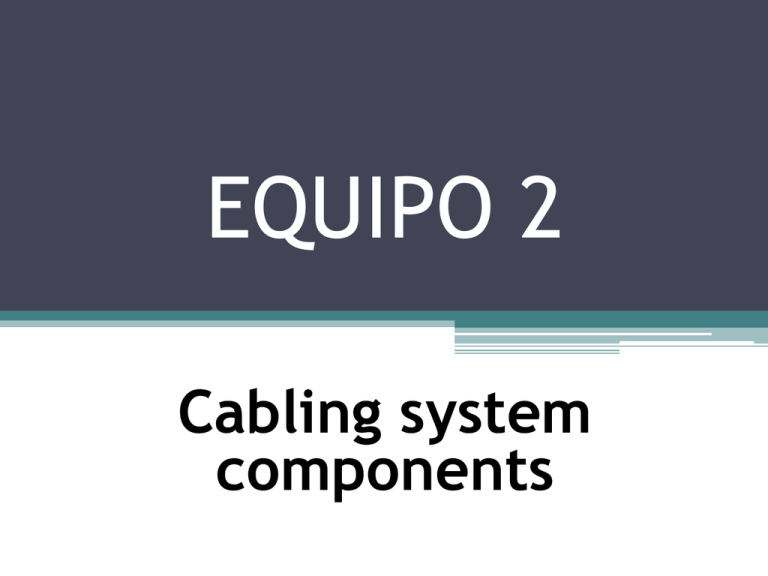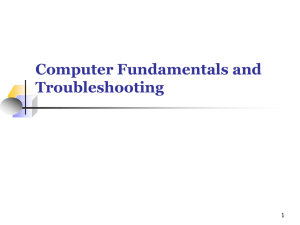Cabling pathways
advertisement

EQUIPO 2 Cabling system EQUIPO 2 components2 EQUIPO The cable Horizontal Cables • Horizontal cables run between a cross-connect panel in a wiring closet and a wall jack, are most often implemented with 100-ohm, four-pair, unshielded twisted-pair (UTP), solid-conductor cables, as specified in the ANSI/TIA/EIA-568 Standard for commercial buildings. • The Standard also provides for horizontal cabling to be implemented: ▫ 62.5/125-micron or 50/125-micron multimode optical fiber ▫ 150-ohm shielded twisted-pair (STP) cable.(but does not recommend) Backbone • Can be implemented using 100-ohm UTP, 62.5/125-micron or 50/125micron multimode optical fiber, or 8.3/125-micron single-mode optical cable. Neither 150-ohm STP nor coaxial cable is allowed. • Optical fiber is the preferred installation medium because of distance limitations associated with copper wiring. a fiber backbone is that glass does not conduct electricity and is thus not subject to electromagnetic interference (EMI) Modular Patch Cables • Modular patch cables (patch cords) are used to provide the connection between field-terminated horizontal cables and network-connectivity devices and connections between the wallplate jack and network devices. • Patch cords are made with stranded conductors because they are more flexible. • Problems with the patch cables: ▫ The first challenge lies within the modular plugs themselves. ▫ the untwisting and splitting of the pairs ▫ the mechanical crimping process that secures the plug to the cable Pick the rigth cable • You must know the installation environment and what the applicable NEC and local fire-code requirements will allow regarding the cables’ flame ratings. • Your second decision on cabling must be on media type.. ▫ For fiber cable, you will need to specify single-mode or multimode, and if it is multimode, you will need to specify core diameter, i.e., 62.5/125 or 50/125. ▫ For UTP cables, you need to specify the appropriate transmission-performance category. Cabling pathways ANSI/TIA/EIA-569-A Commercial Building Telecommunications Pathways and Spaces Standard for concealing, protecting, and routing your cable plant. Must be electrically grounded per the ANSI/TIA/EIA-607 CommercialBuilding Grounding and Bonding Requirements for Telecommunications. CONDUIT Conduit is pipe. It can be metallic or nonmetallic, rigid or flexible and it runs from a work area to a wiring closet. Only 40 percent full by your current cable needs. Conduit should only be filled to a maximum of 60 percent, so this margin leaves you with room for future growth. Cable Trays Cable trays are typically wire racks specially designed to support the weight of a cable infrastructure. Cables simply lie within the tray, so they are very accessible when it comes to maintenance and troubleshooting. Raceways Raceways are special types of conduits used for surface mounting horizontal cables are mounted on the outside of a wall in places where cable is not easily installed inside the wall. Fiber-Protection Systems As with raceways, fiber-protection systems are special types of conduits and cablemanagement systems designed specifically to address the special protection needs of optical-fiber cable. Although maintaining is important for all cable media, cable will eventual signal loss, which translates to lost data, troubleshooting, downed network connections, and lost productivity. Conectores y terminales fijas Wiring Closets TIA / EIA • ANSI/TIA/EIA-568-B • ANSI/TIA/EIA-569-A Additional requirements • There shall be a minimum of two dedicated 120V 20A nominal, nonswitched, AC duplex electrical-outlet receptacles, each on separate branch circuits. • There shall be a minimum of one room per floor to house telecommunications equipment/ cable terminations and associated cross-connect cable and wire. • Lighting shall be a minimum of 500 lx (50 footcandles) and mounted 2.6 m (8.5 feet) above the floor • There shall be a minimum door size of 910 mm (36 inches) wide and 2,000 mm (80 inches) high without sill, hinged to open outward or slide side-to-side or be removable, Wall-Mounted Brackets • For small installations and areas where economy of space is a key consideration, wall-mounted brackets may provide the best solution. Wall-mounted racks such as MilesTek’s Swing Gate wall rack in Figure 5.9 have a frame that swings out 90 degrees to provide access to the rear panels and include wire guides to help with cable management. Wall-Mounted Brackets wall-mount rack with cable management Skeletal Frames Wall-Mounted Brackets Full Equipment Cabinets Shelves available for 19-inch racks Electrical Grounding • Electrical Grounding • Cross-Connect Devices • The 66 Punch-Down Blocks Modular Patch Panels Fiber-Optic Connector Panels A fiber-optic connector panel A consolidation point Administration Standards NOTE. Network administrators should be judged by the neatness of their wiring closets.




